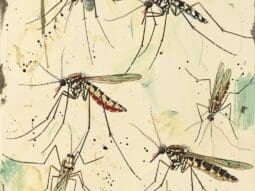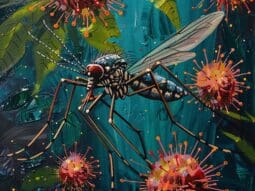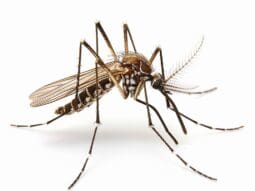
Get Tick Free
When you're back from the great outdoors, you've probably got more than just memories tagging along. Ticks, those tiny bloodsuckers, could be clinging to you, and they're not just a nuisance—they can be a health hazard. It's crucial to make a tick check part of your routine; a quick 30-second scan could save you a lot of trouble.
Showers aren't just for washing off the day's sweat. When it comes to ticks, especially those minuscule ones that transmit infections like Lyme disease, a shower might just be your best defense. And let's not forget your furry friends—they need a tick check too. Your post-adventure habits can make all the difference in keeping these pests at bay.
Understanding Ticks
What Are Ticks?
Ticks are parasitic arachnids with a talent for stealth and survival in nature. They belong to three main families: Ixodidae, Argasidae, and Nuttalliellidae. With around 700 species globally, these tiny pests are skilled at hiding in plain sight, often no bigger than a grain of sand in their larval stage. They're encountered not just in dense forests or on serene hikes but can also be lurking in your own backyard. These bloodsuckers are hardy; they latch onto hosts and feed quietly, making them difficult to detect.
The Dangers of Ticks
The real threat posed by ticks lies in their potential as disease carriers. Their bites can transmit infections from a list that includes Lyme disease, Rocky Mountain spotted fever, and ehrlichiosis, among others. These diseases can lead to serious health complications if not identified and treated promptly. Furthermore, ticks are not picky about their hosts and will readily feed on humans and animals. Impressively resilient, some ticks can remain attached to their hosts for up to 10 days, which enhances the risk of disease transmission. It’s crucial to be vigilant, especially during the warmer months when ticks are most active and populations grow due to favorable climatic conditions.
Identifying Tick Infestations
Ticks favor environments that provide darkness and moisture, which can be as close as the unkempt edges of your yard. Ideal habitats for ticks include areas with:
- Tall grass
- Moist soil
- Dense shrubs or ground cover
- Plenty of shade
Even if you spot deer or small rodents in your surroundings, it's not a definitive sign of a tick presence; testing is the only sure way to know if your yard is hosting these parasites. As for your pets, regular checks are essential. Look out for any unusual lumps or bumps, especially around the head, neck, and ears, as these can be telltale signs of ticks trying to make a meal out of your furry companions. Remember, while they start small, a feeding tick's body swells significantly, resembling a kernel of corn in size.
Tick Prevention Strategies
Creating a Tick-Free Zone in Your Yard
Keeping ticks out of your yard can be a key step in prevention. It's important to maintain short grass and remove potential tick habitats, such as leaf piles, to curtail their presence. Tick-safe zones can be established by laying down wood chips or gravel, which can be a barrier to tick migration into recreational areas. Another effective measure is to use dry barriers like mulch around the perimeter of your lawn, as these create an environment that's inhospitable for ticks. Regular yard clean-up, including pruning bushes and removing debris, minimizes the hideouts for ticks and their wildlife hosts.
Using Tick Repellents
A vital part of tick prevention is the use of repellents on skin and clothing. Products with 20-50% DEET have been shown to be effective. Options like 3M Ultrathon or repellents containing Picaridin are recommended for those who are venturing into areas where ticks are common. For pets, monthly flea and tick treatments prescribed by a veterinarian provide ongoing protection. Remember, while certain over-the-counter pesticides exist, they may not be the safest or most effective option, especially for animal companions.
Checking for Ticks after Outdoor Activities
After spending time in environments conducive to ticks, it's crucial to perform thorough checks. Inspect all over your body, as ticks may crawl for an hour before finding a place to latch on. Pay special attention to hidden areas, such as underarms, behind knees, and other creases. Clothes should be examined and possibly run through a high-heat dryer cycle to kill any lingering ticks. If you find an attached tick, use tweezers to remove it promptly, pulling straight out, close to the skin. Don't forget to check your pets too—look through their fur and inspect their bedding regularly for signs of tick activity.
Tick Removal Methods
When you find a tick on your skin, it's important to remove it promptly to reduce the risk of disease transmission. Let's look at some effective ways to do this.
Tweezers Method
For many, tweezers are the go-to tool for tick removal. You must act quickly and carefully to minimize the chances of infection. First, clean the area with soap and water or rubbing alcohol. Using clean, fine-tipped tweezers:
- Grasp the tick as close to the skin's surface as possible.
- Pull upward with steady, even pressure. Don't twist or jerk the tick; this can cause parts of the tick to break off and remain in the skin, leading to infection.
- If mouth-parts do break off, try to remove them with the tweezers. If unable to remove them easily, leave them alone and let the skin heal.
- After removing the tick, thoroughly clean the bite area and your hands with rubbing alcohol, an iodine scrub, or soap and water.
- Dispose of the tick by placing it in alcohol, sealing it in a bag, wrapping it tightly in tape, or flushing it down the toilet.
Tick Removal Tool Method
Specialized tick removal tools are designed to remove the entire tick more safely and effectively than conventional tweezers. To use one:
- Slide the tool's notch under the tick until it is securely held.
- Follow the manufacturer's instructions to lift or twist the tick free.
- Do not squeeze the body of the tick as it can cause pathogens to be injected into the wound.
- As with tweezers, clean the area and dispose of the tick appropriately.
Tick removal tools come in various shapes and sizes. Choose one suitable for all tick sizes to be prepared for any situation.
Natural Tick Removal Methods
While there's an allure to home remedies and natural methods, it's crucial to approach these with caution. Traditional folklore methods like nail polish, petroleum jelly, or heat can actually increase the risk of disease transmission. Ticks need to be removed immediately, and these methods may cause the tick to burrow deeper or regurgitate saliva into the wound, enhancing the potential for infection.
Instead, focus on:
- Keeping the affected area clean.
- Using tools or methods proven to safely remove the entire tick without causing it further stress.
- Consulting with a healthcare professional if you have concerns, especially if you encounter symptoms indicative of a tick-borne illness.
Remember, proper tick prevention carries equal weight in avoiding bites in the first place. Stay vigilant and employ prevention techniques to keep your experiences in nature enjoyable and tick-free.
Dealing with Tick Bites
Clean the Bite Area
Once you've safely removed the tick, your next step is to clean the bite area thoroughly. Use soap and water to wash the skin around the tick bite. For an extra layer of precaution, apply rubbing alcohol or an iodine scrub to disinfect the site. Ticks can carry various pathogens, so ensuring that the bite area is properly cleansed is crucial to prevent potential infections. Should you notice any tick parts left in the skin, do not dig or squeeze the area; your skin will naturally push out any remnant over time. Remember, a modest pimple-like bump might appear post-removal, signaling an irritation response; this is typical and not generally a cause for alarm.
Monitor for Symptoms
After addressing the bite, it’s essential to keep an eye on the area for changes and stay vigilant for symptoms that could indicate a tick-related illness. Classic signs of tick-borne diseases include fever, headache, fatigue, and muscle aches. Specifically, look out for a rash resembling a bullseye, known as erythema migrans, which may indicate Lyme disease. This rash usually appears within a week and can expand to over two and a half inches. It’s also recommended to note the date of the tick removal and where you probably acquired the tick, as this information could be valuable in case you develop symptoms.
Seek Medical Attention if Needed
If you experience symptoms such as a rash or fever in the weeks following a tick bite, it’s time to consult a healthcare professional. Provide your doctor with all pertinent details, including when and where you may have been bitten and the timeline of any symptom development. In certain cases, your physician may want to identify the tick species; if possible, bring the tick preserved in alcohol in a sealed bag or container. Quick medical response to tick bites is critical as some tick-borne diseases like Anaplasma capra can lead to serious and possibly life-threatening conditions if left untreated.
Tick Control for Pets
Tick Prevention Products for Pets
Your pets require special attention to protect them from ticks. Monthly flea and tick treatments prescribed by your veterinarian are a frontline defense. These products are designed to be safe for your pet and will effectively repel ticks. Opt for treatments like spot-on medications, oral tablets, or tick collars. Remember, over-the-counter pesticides are often ineffective and potentially harmful, so always seek professional advice.
Regular Tick Checks on Pets
After outdoor activities, it's critical to perform thorough tick checks on your furry friends. Ticks can easily hide in the fur, so be meticulous. Start by examining around the neck, inside the ears, and between the toes. Your pet's bedding should not be overlooked; inspect it regularly for any signs of tick infestation to catch these pests early.
Consult a Veterinarian for Tick Control
If you're unsure about the best tick prevention strategy for your pet, it's wise to consult a veterinarian. They can recommend specific products tailored to your pet's needs and environment. Additionally, they'll advise on the proper removal of ticks to minimize the risk of disease. If you find ticks on your pet, discuss with your vet the appropriate next steps, including potential disease testing.
Conclusion
You're now equipped with a comprehensive checklist to tackle ticks effectively. Remember, diligence in creating a tick-free zone and using repellents is key to keeping these pests at bay. Stay vigilant with regular checks and proper tick removal techniques to protect yourself and your pets. By incorporating these practices into your routine, you'll minimize the risk of tick-borne diseases and enjoy the outdoors with greater peace of mind. Stay safe and tick-free!
Frequently Asked Questions
What keeps ticks away naturally?
Natural tick repellents include commercially available products containing essential oils such as lemongrass, cedar, peppermint, geraniol, and thyme. These ingredients are selected for their ability to repel ticks.
Will your body naturally push out a tick head?
It's possible for the skin to heal and naturally expel a tick head over a period of 1 to 2 weeks. However, a remaining tick head can increase the risk of a localized skin infection.
What smell makes ticks go away?
Cedarwood has a musky scent that is toxic to ticks and their larvae. Its repellent qualities and safety for use on humans and pets make it an excellent choice.
What is the fastest way to get rid of ticks?
The fastest way to get rid of ticks is to maintain short grass, create tick-free zones, eliminate other pests, plant tick-repellent vegetation, and use tick-killing chemicals.
Do coffee grounds keep ticks away?
While not scientifically proven, anecdotal evidence suggests spreading coffee grounds may help repel chiggers, fleas, and ticks, especially if applied to high ground to allow natural distribution through wind and rain.
Still haven't found the information you are looking for? Provide your information below, and we will use our AI Pest Detective to provide your next steps and deliver more specifics to your inbox.
Your Journey to Pest-free
50+ Years Experience. Eco-Friendly, Pet-Friendly, and Kid-Friendly Treatments. Results Guaranteed. Romex Pest Control
Romex Pest Control is committed to protecting you, your children, and your pets with our eco-friendly, child-friendly, and pet-friendly guaranteed pest control solution.
We are confident in solving all pest, rodent, and termite problems.
Romex Pest Control is fully insured and licensed in Texas, Oklahoma, Louisiana, and Mississippi.
Established 2016 © Copyright 2024 Romex Pest Control










